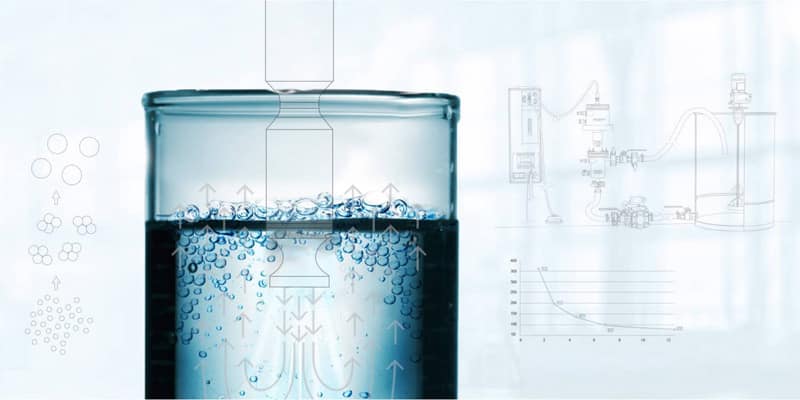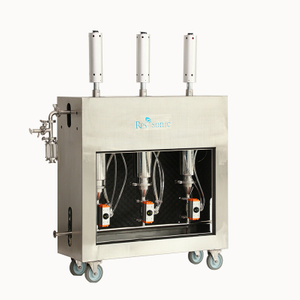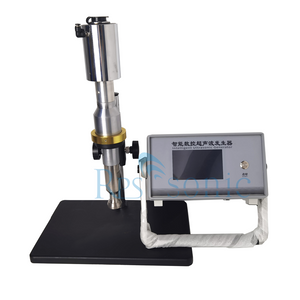Application: Ultrasonic-Oxidative Extraction Desulfurization of Sulfur-Containing Diesel
Abstract:
A method for ultrasonic-oxidative extraction desulfurization of sulfur-containing diesel fuel is characterized by using oxygen (O₂) or air as the oxidant during the oxidation process.
This method combines ultrasonic action, catalytic oxidation, and extractive desulfurization. Under normal pressure and near-ambient temperature conditions, the sulfur content of diesel fuel reaches the National V diesel quality standard (<15 μg/g) in a very short time, achieving a desulfurization rate exceeding 96%. Compared to existing desulfurization technologies, the method of the present invention not only achieves significant desulfurization results and shortens reaction time, improving production efficiency, but also offers mild reaction conditions, low equipment investment and operating costs, a simple process flow, and low production costs. This makes it an energy-saving, efficient, and environmentally friendly desulfurization process.
With increasingly stringent environmental regulations and increasingly stringent fuel oil quality requirements worldwide, the production of low-sulfur "clean fuel" has become an inevitable trend. Therefore, in the face of increasingly stringent diesel sulfur content limits and the huge market demand for low-sulfur clean diesel fuel, improvements and innovations in diesel desulfurization methods are of great practical significance. Sulfur compounds in diesel are primarily alkylbenzothiophenes and alkyldibenzothiophenes. The presence of these compounds not only contributes to SOx pollution during diesel use but also significantly contributes to NOx and particulate matter emissions from diesel vehicle exhaust. Currently, the primary technology for industrial production of low-sulfur diesel, both domestically and internationally, is hydrodesulfurization (HDS). Under high temperature and pressure, hydrogenation is performed using a catalyst to convert organic sulfur in diesel into H2S. This technology is limited by the high cost of hydrogen, demanding reaction conditions, high investment and operating costs, and the difficulty in removing sterically hindered dibenzothiophene-based organic sulfur compounds, which hinder the production of ultra-low-sulfur diesel.
Ultrasonic oxidative desulfurization has become a recognized and highly effective desulfurization method. CN 01136396.7 reports that the diesel oxidative desulfurization process, using the oxidant H2O2, combines ultrasound, phase transfer catalysis, and metal catalysis-oxidation. At near-ambient temperature and pressure, the process achieves a diesel desulfurization rate of 99% or higher within minutes. A H2O2-organic acid catalytic oxidation desulfurization reaction system was selected, and ultrasound was introduced to provide reaction energy. Results showed that the diesel catalytic oxidation reaction was carried out at room temperature, with a catalyst-to-oil ratio of 0.05, a stirring rate of 300 r/min, a reaction time of 15 min, a frequency of 28 kHz, and an acoustic intensity of 0.408 W/cm2. The resulting product was mixed with an extractant (DMF) at a 1:1 ratio at room temperature, extracted twice, and then separated. The desulfurization rate was 94.8%, while the desulfurization rate without ultrasound was only 67.2%. This indicates that ultrasonic oxidation desulfurization is significantly superior to oxidation desulfurization without ultrasound.
The technical solution of the present invention is a method for ultrasonic-oxidative extraction desulfurization of sulfur-containing diesel fuel, comprising the following specific steps:
A. Dissolving a free radical initiator and an aldehyde in a solvent, and introducing a gaseous oxidant by bubbling at a temperature between 15°C and 80°C to carry out a reaction;
B. Mixing the reaction solution obtained in step A (containing the aldehyde, free radical initiator, and solvent) with sulfur-containing diesel fuel in a volume ratio of 1:0.5 to 1:10, and then introducing a gaseous oxidant by bubbling at a temperature between 15°C and 80°C to carry out an oxidation reaction using ultrasonic and mechanical stirring;
C. Allowing the reaction mixture to stand for separation to separate the oil phase and the solvent phase; and washing and drying the oil phase to obtain desulfurized diesel fuel. The reaction in step (1) is characterized in that it is a free radical reaction, and the mechanism is as follows: (wherein R, R', R" represent alkyl groups, and R'OOR" represents an organic peroxide)
In the above step (1), the free radical initiator is an organic peroxide, preferably cyclohexanone peroxide, dibenzoyl peroxide, isopropylbenzene hydroperoxide, or alkyl hydroperoxide; the preferred aldehyde is n-octanal, benzaldehyde, or isobutylaldehyde; the preferred gaseous oxidant is O2 or air; and the preferred solvent is acetonitrile or N,N-dimethylformamide. When the organic peroxide is used as the oxidant without the participation of aldehyde, O2, or air in the reaction, and the diesel is subjected to ultrasonic-oxidative extraction desulfurization treatment alone, the results show that the organic peroxide has no significant effect on the oxidative desulfurization of diesel under this oxidation system.
The volume ratio of free radical initiator: aldehyde: solvent in step A is preferably 1:3-8:30-40.
The same gaseous oxidant is preferably used in steps A and B. The volume ratio of the total amount of gaseous oxidant consumed (under standard conditions) to sulfur-containing diesel in steps A and B is 10-150:1. When the gaseous oxidant is O₂, the volume ratio of the total amount of O₂ consumed (under standard conditions) to sulfur-containing diesel is more preferably 10-30:1. When the gaseous oxidant is air, the volume ratio of the total amount of air consumed (under standard conditions) to sulfur-containing diesel is 50-150:1. The amount of gaseous oxidant consumed in step A is preferably 1/3 to 1/2 of the total amount of gaseous oxidant consumed in steps A and B.
The reaction time in step A is preferably 5-50 minutes; the reaction time in step B is preferably 1-45 minutes; and the standing time of the mixed solution in step C is preferably 5-30 minutes. Steps A and B are carried out under normal pressure, generally 0.08 MPa to 0.2 MPa. The oxidation reaction described in step B is enhanced by ultrasound and mechanical stirring; wherein the ultrasound enhancement is probe-type; the mechanical stirring is paddle-type; the mechanical stirring plays a role in macro-mixing of the reaction system, while the ultrasound not only enhances the reaction but also plays a role in micro-mixing.
The preferred ultrasound frequency is 20kHz to 40kHz, and the ultrasound action time is 1min to 45min.
The oil phase water washing process in step C is carried out at a temperature of 10°C to 90°C and a pressure of 0.1MPa to 0.3MPa; the water washing is performed twice using NaHCO3 solution or Na2CO3 solution and water, preferably distilled water; the drying process is dried with anhydrous Na2SO4 or anhydrous CaCl2.
Beneficial effects:
(1) The present invention provides a low-cost oxidant using widely available O2 or air; it overcomes the cost (high price, large amount) and environmental (post-treatment required) problems associated with using H2O2 as an oxidant. (2) The oxidation reaction and extraction process provided by the present invention are carried out simultaneously. The use of ultrasonic waves in the diesel oxidation process significantly enhances the oxidation intensity and significantly improves the oxidation conversion rate of organic sulfides in diesel. At the same time, due to the presence of an extractant (acetonitrile or DMF) in the reaction liquid, the oxidized diesel is also subjected to ultrasonic extraction treatment, which greatly improves the desulfurization rate and reduces the sulfur content of diesel. The desulfurization rate can reach more than 96%, which is a very significant effect. The above process can be completed in just a few minutes, which improves production efficiency and can be used for large-scale industrial production. (3) The present invention introduces a small amount of organic peroxide into the oxidation reaction system, which not only shortens the oxidation reaction time and significantly improves the desulfurization rate, but also improves the cetane number of diesel and promotes combustion. (4) The reaction conditions provided by the present invention are mild and can be operated at a temperature of 30°C to 60°C and at normal pressure. No hydrogen source and pressure-resistant equipment are required, equipment investment and operating costs are low, the process flow is simple, and it is an energy-saving and efficient desulfurization process route. (5) The raw materials used in this invention are readily available, require minimal amounts, and are low-cost. The oxidative desulfurization effect is significant, and the sulfur content of the treated diesel meets the national Class V diesel quality standard (<15 μg/g). Therefore, this oxidative extraction desulfurization technology has promising industrial application prospects and can generate high economic and social benefits.


 English
English














